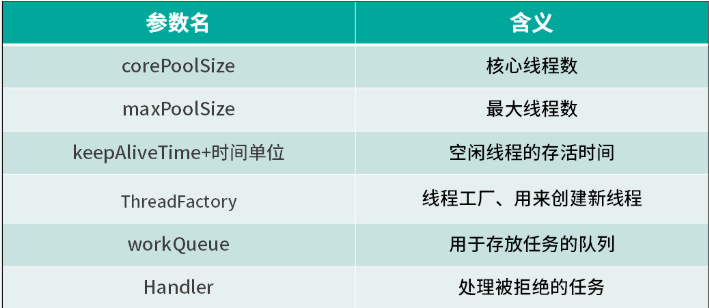线程池
1.sleep 与 wait 的区别
sleep不会让出锁,而wait会让出锁.
2.调用线程的interrupt方法,即使线程wait或者sleep也能感知到,并抛出异常
3.线程的6种状态,
-
New(新创建)
-
Runnable(可运行)
-
Blocked(被阻塞)
-
Waiting(等待)
-
Timed Waiting(计时等待)
-
Terminated(被终止)
block是指在进入synchronize修饰的方法没有获得monitor锁
waiting是指调用wait/join/LockSupport.park
Timed Witing:线程调用sleep方法
4.线程池

刚开始随着任务的进来,线程池会创建核心线程来执行,当创建到corePoolSize之后,任务就会被存放到工作队列里面。当工作队列满了的时候,就又会创建线程直到maxPoolSize。如果队列还是满了的话,就会执行拒绝策略.
线程池的实现原理
首先,线程池中用一个AtomicInteger的高三位来表示状态位,低29位来表示线程的数量
private final AtomicInteger ctl = new AtomicInteger(ctlOf(RUNNING, 0)); // 这里 COUNT_BITS 设置为 29(32-3),意味着前三位用于存放线程状态,后29位用于存放线程数 // 很多初学者很喜欢在自己的代码中写很多 29 这种数字,或者某个特殊的字符串,然后分布在各个地方,这是非常糟糕的 private static final int COUNT_BITS = Integer.SIZE - 3; // 000 11111111111111111111111111111 // 这里得到的是 29 个 1,也就是说线程池的最大线程数是 2^29-1=536870911 // 以我们现在计算机的实际情况,这个数量还是够用的 private static final int CAPACITY = (1 << COUNT_BITS) - 1; // 我们说了,线程池的状态存放在高 3 位中 // 运算结果为 111跟29个0:111 00000000000000000000000000000 private static final int RUNNING = -1 << COUNT_BITS; // 000 00000000000000000000000000000 private static final int SHUTDOWN = 0 << COUNT_BITS; // 001 00000000000000000000000000000 private static final int STOP = 1 << COUNT_BITS; // 010 00000000000000000000000000000 private static final int TIDYING = 2 << COUNT_BITS; // 011 00000000000000000000000000000 private static final int TERMINATED = 3 << COUNT_BITS; // 将整数 c 的低 29 位修改为 0,就得到了线程池的状态 private static int runStateOf(int c) { return c & ~CAPACITY; } // 将整数 c 的高 3 为修改为 0,就得到了线程池中的线程数 private static int workerCountOf(int c) { return c & CAPACITY; } private static int ctlOf(int rs, int wc) { return rs | wc; }
int c = ctl.get(); if (workerCountOf(c) < corePoolSize) { if (addWorker(command, true))//判断当前线程数是否小于核心线程数,如果小于就添加线程 return; c = ctl.get(); } if (isRunning(c) && workQueue.offer(command)) { int recheck = ctl.get(); if (! isRunning(recheck) && remove(command)) reject(command); else if (workerCountOf(recheck) == 0) addWorker(null, false); } else if (!addWorker(command, false)) reject(command); }
private boolean addWorker(Runnable firstTask, boolean core) { retry: for (;;) { int c = ctl.get(); int rs = runStateOf(c); // Check if queue empty only if necessary. if (rs >= SHUTDOWN && ! (rs == SHUTDOWN && firstTask == null && ! workQueue.isEmpty())) return false; for (;;) { int wc = workerCountOf(c); if (wc >= CAPACITY || wc >= (core ? corePoolSize : maximumPoolSize)) return false; if (compareAndIncrementWorkerCount(c)) break retry; c = ctl.get(); // Re-read ctl if (runStateOf(c) != rs) continue retry; // else CAS failed due to workerCount change; retry inner loop } } boolean workerStarted = false; boolean workerAdded = false; Worker w = null; try { w = new Worker(firstTask); //Worker对象实现了Runnable方法,在构造函数中线程工厂创建线程,worker对象本身作为参数. final Thread t = w.thread; if (t != null) { final ReentrantLock mainLock = this.mainLock; mainLock.lock(); try { // Recheck while holding lock. // Back out on ThreadFactory failure or if // shut down before lock acquired. int rs = runStateOf(ctl.get()); if (rs < SHUTDOWN || (rs == SHUTDOWN && firstTask == null)) { if (t.isAlive()) // precheck that t is startable throw new IllegalThreadStateException(); workers.add(w); int s = workers.size(); if (s > largestPoolSize) largestPoolSize = s; workerAdded = true; } } finally { mainLock.unlock(); } if (workerAdded) { t.start();//就是调用了Worker对象的run方法() workerStarted = true; } } } finally { if (! workerStarted) addWorkerFailed(w); } return workerStarted; }
public void run() { runWorker(this); }
final void runWorker(Worker w) { Thread wt = Thread.currentThread(); Runnable task = w.firstTask; //传入的任务 w.firstTask = null; w.unlock(); // allow interrupts boolean completedAbruptly = true; try { while (task != null || (task = getTask()) != null) {//线程在这里循环工作,从阻塞队列中拿出任务 w.lock(); // If pool is stopping, ensure thread is interrupted; // if not, ensure thread is not interrupted. This // requires a recheck in second case to deal with // shutdownNow race while clearing interrupt if ((runStateAtLeast(ctl.get(), STOP) || (Thread.interrupted() && runStateAtLeast(ctl.get(), STOP))) && !wt.isInterrupted()) wt.interrupt(); try { beforeExecute(wt, task); Throwable thrown = null; try { task.run();//直接调用run方法, } catch (RuntimeException x) { thrown = x; throw x; } catch (Error x) { thrown = x; throw x; } catch (Throwable x) { thrown = x; throw new Error(x); } finally { afterExecute(task, thrown); } } finally { task = null; w.completedTasks++; w.unlock(); } } completedAbruptly = false; } finally { processWorkerExit(w, completedAbruptly); } }




 浙公网安备 33010602011771号
浙公网安备 33010602011771号